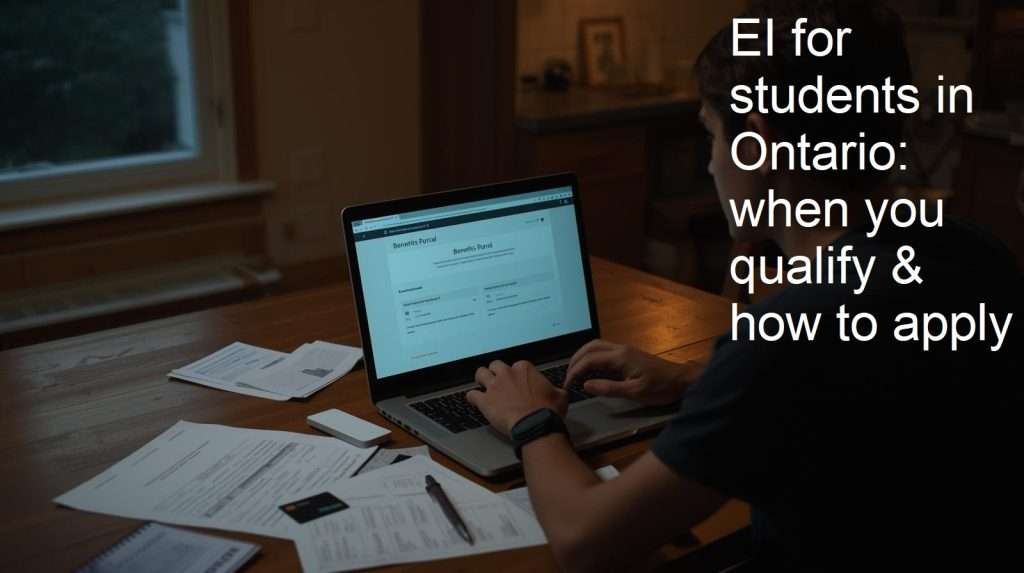Students can qualify for Employment Insurance (EI) in Ontario, but two things decide most outcomes: enough insurable hours and whether you’re truly available for work. This guide explains summer-job claims, ROE requirements, what to report once school starts, and how international-student work limits affect eligibility.
New to Ontario? Get your SIN first.

Who actually qualifies (student edition)
To receive EI Regular benefits, you generally need:
- Sufficient recent insurable hours (threshold varies by region; typically 420–700 hours), and
- An interruption of earnings (usually 7 consecutive days with no work/insurable pay from that employer), and
- To be capable of and available for work and actively job-searching.
You must also apply as soon as you stop working—even if your ROE hasn’t arrived yet. Filing late can cost you weeks of benefits.
If EI won’t apply, compare OSAP options to fund the term.
Summer job EI: common scenarios
If your full-time summer job ends, that’s normally an interruption of earnings, so you can apply for EI right away. If you return to full-time classes, however, there’s a longstanding presumption that full-time students aren’t available for work during normal hours; you can be disentitled unless you rebut that presumption (for example, by proving genuine full-time availability and active job search).
Tip: Some students qualify for EI during the summer break but lose entitlement once classes resume unless they prove ongoing availability—or their training is referred/approved by a designated authority under EI rules. Declare any course before it starts so Service Canada can assess.
ROE (Record of Employment): what it is & when you need it
Your employer issues an ROE when you have an interruption of earnings. Service Canada uses it to confirm your insurable hours and earnings. Most ROEs are filed electronically; you can still apply without it and the system will match it later.
When does an interruption happen? In most cases: 7 straight days with no work and no insurable earnings from that employer (end-of-contract summer jobs usually meet this). Certain non-standard schedules are exceptions.
Food-service roles? Start with a Food Handler certificate.
Reporting while you’re in school
Once you’re on claim, you must report every 2 weeks. Declare:
- Any work hours/earnings,
- Hours spent in school or training, and
- Whether you were available for work.
Answer truthfully; mismatches can stop payments or trigger reviews.
If your course is not referred/approved, expect questions about your availability once classes begin (daytime attendance often conflicts with “ready, willing, and able to work” expectations).
International students: key restrictions
EI looks at insurable work + availability, not your citizenship. If you paid EI premiums and have enough hours, you can be eligible. But to be “available,” you must be legally allowed to work the hours employers need.
Since Nov 8, 2024, most international students can work up to 24 hours/week off-campus during academic sessions (full-time during scheduled breaks). That cap can make it hard to prove full-time availability during school terms, which often leads to disentitlement for EI Regular while classes run.
Practical read: Many international students only qualify during scheduled breaks (when full-time work is allowed) or if they finish studies and remain work-authorized. Always disclose student status on reports.
Read: Mature student Ontario: returning to school after 25
How to apply (step-by-step)
- Apply ASAP (don’t wait for your ROE). Go online via My Service Canada Account.
- Have this ready: SIN, banking for direct deposit, employer details, reason for separation, and dates.
- ROE follows: If it’s not filed yet, your claim still starts; Service Canada will add the ROE when received.
- Complete bi-weekly reports (work hours, school/training hours, availability).
- If starting/attending school, declare it before the course starts so they can assess availability or referral status.
Quick numbers example (summer job)
- You worked 16 weeks full-time (≈640 hours). Your job ends Aug 31.
- You apply immediately; your ROE is e-filed a few days later.
- You may be paid in September if you remain available for work; if you resume full-time classes, expect an availability review and potential disentitlement until the next academic break.
FAQ
How many hours do I need for EI Regular?
Between 420 and 700 insurable hours, depending on your EI region’s unemployment rate.
Can I get EI while in full-time school?
Possibly, but there’s a presumption you’re not available; you must rebut it (or be in referred training). Many claims stop when classes start.
Can I apply before my ROE is issued?
Yes—apply right away to protect weeks; the ROE can arrive later.
Do international students qualify?
If you paid EI, have enough hours, and are legally available for work, you can be eligible. But the 24-hour off-campus cap during class often limits “availability,” so many only qualify during scheduled breaks.
Key takeaways
- Apply immediately when your summer job ends; don’t wait for the ROE.
- Expect a school-term availability test; full-time students are presumed not available unless they prove otherwise or are referred to training.
- ROE proves your hours/earnings; most are e-filed, but your claim can start without it.
- International students: off-campus work is 24 hrs/week during classes; that cap can block EI Regular during terms.
How i wrote this: Verified EI eligibility (hours, interruption of earnings, apply-now rule), ROE guidance, bi-weekly reporting, student availability presumption, and IRCC off-campus limits on 2025-11-09 using current federal pages and tribunal decisions.

